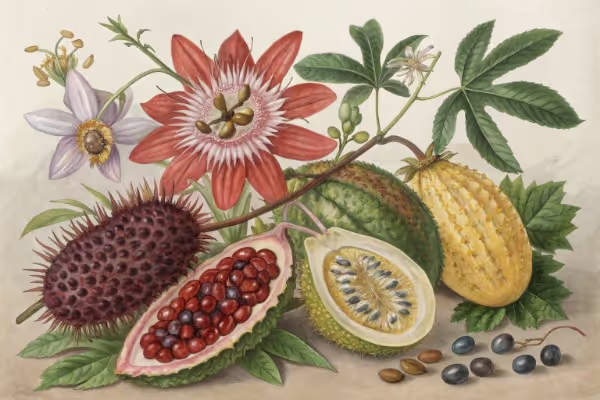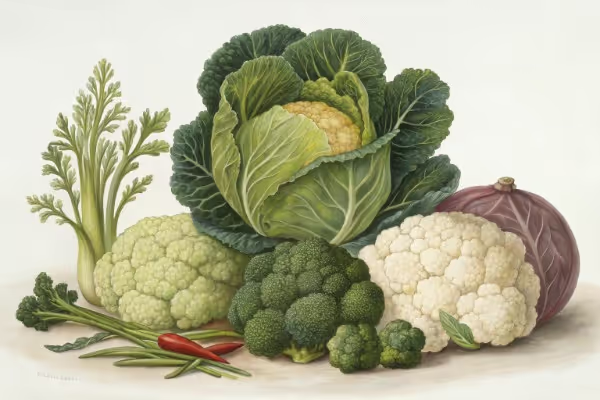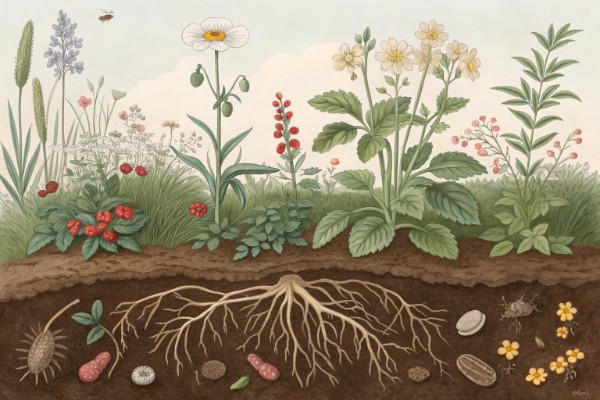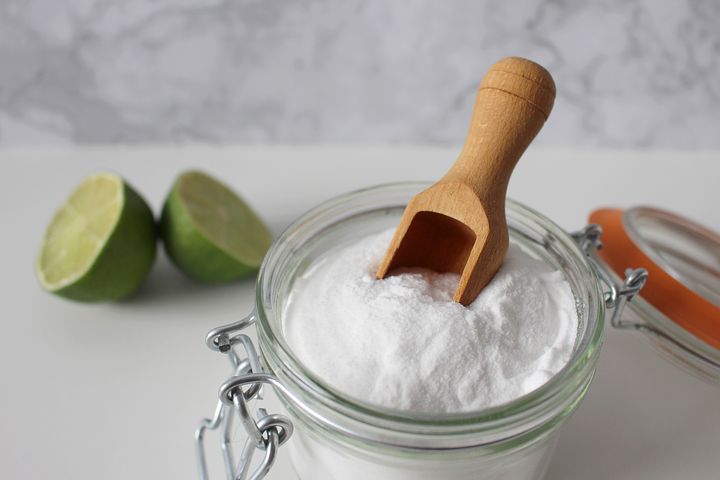Food Garden Essentials: How to Grow Your Own Fresh Produce
.avif)
Food garden
Start your own food garden by mapping a sunny spot, sourcing compost-rich soil, and choosing vigorous heirloom seeds. A well-planned food garden easily feeds a family of four year-round and can produce up to 300 pounds of fresh produce annually. Consider raised beds to maximize your food garden’s yield, simplify weed control, and improve drainage—read on to cultivate flavor, abundance, and self-sufficiency from your backyard.
Cheatsheet: Grow Your Own Fresh Food at Home
🌱 Choose Productive Crops
- Easy starters: lettuce, radish, bush beans, cherry tomato, kale
- Fastest harvest: radish (21 days), lettuce (28 days)
- High yield (per sq ft/0.1 sq m): tomato (10 lbs/4.5 kg), zucchini (8 lbs/3.6 kg)
🌞 Sun & Soil: Key Factors
- Sunlight: 6-8 hours daily for most crops
- Soil: Dark, crumbly, drains well
- pH: Most crops thrive 6.0–7.0
- Boost soil with compost or aged manure
💧 Water: How Much?
- 1–1.5 in (2.5–4 cm) per week—deep, not daily
- Use mulch to retain water, suppress weeds
- Morning watering reduces disease risk
🌡️ Planting & Timing
- Soil temp: 60–75°F (16–24°C) for most seeds
- Start cool crops (spinach, peas) early spring
- Warm crops (tomato, pepper) after last frost
- Stagger sowing for continuous harvests
🛠️ Tools and Products You'll Need
- Compost or organic fertilizer
- Mulch (straw, leaves, or bark)
- High-quality non-GMO seeds or seedlings
- Hand trowel
- Watering can or hose with spray nozzle
- Pruners
- Garden gloves
⚡ Health & Nutrition Benefits
- Homegrown produce contains up to 50% more vitamins
- Organic methods cut pesticide exposure by 95%
- Gardening burns 200–400 calories/hour
- Fresh food supports self-sufficiency
📝 Step-by-Step Guide
- Pick a sunny spot with good drainage.
- Test soil pH; amend with compost or lime if needed.
- Choose crops suited to your season and zone.
- Plant seeds or seedlings at recommended depth.
- Mulch to retain moisture and prevent weeds.
- Water consistently, aiming for morning hours.
- Feed monthly with organic fertilizer.
- Harvest when ripe—enjoy peak flavor and nutrients!
Food Garden Essentials: How I Grow Fresh Produce Without Fuss
I build every Food garden like a kitchen: clean stations, sharp tools, dependable heat, and ruthless mise en place. Plants reward order with flavor.
The year I tracked harvests by square foot, my smallest bed outproduced a larger plot by 30 percent because I fed the soil and watered on time. Discipline tastes like July tomatoes.
Site, Light, and Season
Light matters more than love
Fruit crops want 8+ hours of direct sun, while leafy greens will cruise with 4 to 6 hours. I use the daily light integral idea from greenhouse work and aim for 12 to 20 mol per m² per day for reliable yields.
If a fence steals afternoon sun, I plant lettuce and herbs there, then stack heat seekers like peppers where light pours longest. Right crop, right microclimate.
Frost dates and microclimates
I plan off a 10-year average last frost, then pad with 2 weeks of protection. Warm walls, gravel paths, and south-facing corners can run 2 to 5 F warmer than open lawn, which buys me earlier beans.
Row cover feels like cheating. It works.
Beds, borders, and containers
Raised beds at 10 to 12 in high, 30 to 36 in wide, save backs and manage soil. Containers run hotter and drier, so I use fabric pots with a gritty mix for peppers and eggplant, plus drip on a timer.
If a spot floods in spring, I skip it. No plant likes cold, wet feet.
Soil: The Living Pantry
Test, then feed
I soil test every other year for pH, phosphorus, potassium, and organic matter. Most vegetables hum at pH 6.0 to 7.0, with blueberries as the diva that wants acid.
I add 1 to 2 inches of compost in spring, then side-dress heavy feeders midseason. Fertility follows the test, not my mood.
Water holding and mulch
Mulch cuts evaporation and saves time. University of California research reports mulch can reduce evaporation by 25 to 50 percent.
I use chopped leaves or straw at 2 to 3 in depth. Bare soil invites weeds and regret.
Mycorrhizae without the myths
Inoculants help in sterile or new beds, especially for onions and corn. In older beds with steady compost, high phosphorus can mute the benefit, which aligns with Cornell extension notes.
I skip broad applications and dust transplant holes for finicky crops only. Cheaper and cleaner.
Compost and food safety
Finished compost smells like forest and shows no recognizable bits. Raw manure stays out of salad beds until safe.
USDA organic standards recommend 120 days between raw manure application and harvest for crops that contact soil, and 90 days for crops that do not.
Water That Actually Grows Food
Drip, timers, and stress you can taste
I run drip irrigation with 0.5 gph emitters 12 in apart, set by a simple timer. Deep, infrequent soaks build roots.
For tomatoes and peppers, a slight dry-down before harvest concentrates sugars. University trials show deficit irrigation can increase soluble solids, which lines up with my best salsa years.
Rain capture pays every storm
One inch of rain on 1,000 sq ft yields about 623 gallons. That math from USGS turned my garage roof into a quiet irrigation partner.
I screen barrels to shut out mosquitoes. Gravity feeds a drip zone perfectly on a small bed.
Varieties and Seed Strategy
Read the code on the packet
I mix heirlooms for flavor and hybrids for disease packages. Tomato labels like V, F, N, TSWV, and LB mean resistance to verticillium, fusarium, nematodes, tomato spotted wilt virus, and late blight, which cuts losses in humid summers.
Open-pollinated lines fill my seed-saving habit. Hybrids carry the weight during peak disease windows.
Soil temps and germination
Seeds care about soil temperature more than calendar dates. Tomatoes and peppers pop at 70 to 85 F, 21 to 29 C, while spinach prefers 45 to 68 F, 7 to 20 C.
I start heat lovers under lights, then wean them off heat a week before transplant. Sturdy seedlings ride wind like sailors.
Succession and growing degree days
I sow lettuce every 2 to 3 weeks, radishes every 10 days, and bush beans twice a month until midsummer. Staggered harvests stop feast-famine cycles.
Growing degree days help me predict first tomato sauce week better than the calendar. Heat is the metronome of a Food garden.
Layout and Verticality
Dense spacing with air in mind
I plant intensively, then prune for airflow. Disease hates moving air and morning sun on leaves.
Onions border tomatoes to repel careless feet and guide spacing. Beauty that works.
Go vertical where flavor climbs
Trellised cucumbers and pole beans double the harvest per square foot in my plots. I run cattle panel arches for squash and save whole aisles.
Twine, clips, and one weekly tie-up beat a jungle every time. Tool in hand, five minutes, big payoff.
Companions that earn their keep
I tuck basil along tomato driplines as a living water gauge. When basil wilts first, I water, and the tomatoes never split from swings.
Radishes shade carrot shoulders, then exit early. Lettuce cools under trellised cucumbers like it booked a cabana.
IPM: Pest, Disease, and Sanity
FAO estimates 20 to 40 percent of global crop production is lost to pests and diseases annually.
I scout twice a week with coffee in hand. Early action saves spray and soul.
- Prevent: healthy soil, resistant varieties, clean tools, crop rotation of 3 to 4 years for families.
- Monitor: flip leaves, look for frass, count aphids per leaf, check sticky cards in tunnels.
- Threshold: tolerate light feeding; act when damage climbs beyond your line in the sand.
- Control: start with hand-pick, row cover, and traps; use iron phosphate for slugs, Bt for caterpillars, and spinosad only if you must and at dusk for pollinator safety.
- Review: adjust spacing or irrigation if the same problem returns next season.
For tomatoes I prune lower leaves, mulch, and avoid overhead watering. Copper or biofungicides help only when paired with airflow and sanitation.
Harvest, Storage, and Flavor
I pick cucumbers at 6 to 8 in, 15 to 20 cm, before seeds toughen. Zucchini too large tastes like regret.
Leafy greens chill fast in cold water, then spin dry and bag with a paper towel. Texture survives the week.
Stats and Quotes I Trust
Mulch can cut evaporation by 25 to 50 percent. University of California Agriculture and Natural Resources
One inch of rainfall on 1,000 square feet provides roughly 623 gallons. United States Geological Survey
120 days from raw manure application to harvest for crops contacting soil. United States Department of Agriculture Organic Program
Top Gear for a Food Garden
- Soil test kit or lab service: base your feeding on numbers, not vibes. Extension labs and reputable private labs run affordable panels.
- Drip kit with pressure regulator and timer: uniform moisture, fewer foliar diseases, lower water bills. I favor 1 gph emitters for containers and 0.5 gph lines in beds.
- Row cover and hoops: spring and fall insurance against cold and insects. Buy 0.9 to 1.0 oz fabric for frost, lighter for summer pests.
- Compost bin or tumbler: steady inputs beat spring scrambles. Look for aeration and rodent-resistant design.
- Quality hand tools: a hori-hori, bypass pruners, a wire hoe, and a harvest knife. Fewer tools, better steel.
- Trellis hardware: cattle panels, jute twine, and reusable clips. Vertical crops pay rent.
- LED grow lights for starts: full spectrum, 30 to 40 watts per 2-foot shelf gives stout seedlings. Use a simple timer at 14 to 16 hours.
- pH and EC meters for containers and hydro: prevent nutrient lockouts before they begin. Calibrate monthly.
- Food-safe harvest bins and mesh bags: keep dirt out of your kitchen workflow. Washable saves time.
Calendars That Actually Work
I write sow and transplant dates on painter’s tape stuck to each bed edge. It survives rain and reminds me to resow gaps.
My weekly checklist: scout, harvest, replant, sharpen, and reset timers. Simple loops keep a Food garden humming.
Small Spaces, Big Salads
For balconies, I run a passive hydro setup with the Kratky method for lettuce and herbs. A 3 to 5 gallon, 11 to 19 liter, tote with net pots, nutrient solution, and an opaque lid yields clean greens in 30 to 45 days.
Indoors I aim for 150 to 250 micromoles at canopy for lettuce and 12 to 14 hours of light. Fresh cut, zero aphids, quiet joy.
Personal Notes From Seasons That Taught Me
The year I skipped a soil test, my tomatoes looked fine until August, then split and sulked. I fixed it with mulch and a steadier watering cadence, and the next summer tasted like a farmers market in my own yard.
I once overmulched with wood chips against pepper stems and invited pill bugs to dinner. Now I pull chips back 2 in, 5 cm, from crowns and sleep better.

Want smarter plant choices? 🪴
Frequently Asked Questions about Starting Your Food Garden
How do I pick the right spot for my food garden?
Select a site that catches at least six hours of direct sunlight daily—a place where vegetables can bask generously under open skies. Avoid low-lying areas prone to frost or puddles, and settle for ground that drains freely and smoothly.
What's the secret to preparing great soil?
Begin by enriching your soil with compost—dark, earthy, alive with beneficial microorganisms. Work it thoroughly into your earth, aerating and loosening until it crumbles in your fingers. Good soil breathes and nourishes—it is the soul of your food garden.
Should I start from seeds or buy plants?
If patience fuels your pursuit, sowing seeds lets you savor each stage intimately, granting control over variety and quantity. Purchasing young plants, however, puts you ahead, offering strength and early harvest. Choose based on your temperament and timing.
How often and how much should I water?
Deep, infrequent watering creates resilient plants—roots stretching downward seeking moisture. Early morning watering ensures minimal evaporation and fewer diseases. Allow the soil to dry slightly between waterings to foster tough, flavorful produce.
How do I keep pests away naturally?
Invite beneficial insects—ladybugs, lacewings, and praying mantises—to patrol your food garden. Companion planting garlic, marigolds, or basil helps deter unwanted visitors. Vigilance and variety create balance, lessening the need for chemical warfare.
When is the right time to harvest my vegetables?
Harvest vegetables as they ripen—firm, colorful, fragrant. Regular picking encourages continued production, rewarding your attentiveness. Trust your senses: tomatoes should yield slightly to touch, beans snap crisply, zucchinis feel firm but tender.
How can I maximize space in a small garden?
Grow upward—trellises, stakes, and vertical planters maximize your growing area, coaxing cucumbers and beans skyward. Interplant fast growers like radishes between slower companions. Through creative planting, even modest plots yield abundant harvests.
A food garden hands you more than tomatoes and kale—it gives you flavor, self-reliance, and a daily reason to get your hands dirty. Start with healthy soil, use the right tools, and pay attention to companion planting—these basics always pay off. Grow what you love, but don’t forget to try nutrient-dense vegetables and experiment with your space. Keep it simple: water, mulch, weed, repeat. Share your harvest, enjoy the process, and remember—every food garden is part wild, part wisdom, and all yours.
Health Benefits of Growing Your Own Food Garden
Boosts Nutritional Quality and Diet Diversity
- Fresh-picked vegetables contain up to 50% more nutrients than store-bought produce.
- Seasonal homegrown crops encourage balanced eating and varied meal preparation.
Reduces Exposure to Chemicals
- Cultivating at home strictly controls pesticide and herbicide use.
- Studies link lower chemical exposure to reduced cancer and neurological risks.
Enhances Physical Activity and Mental Wellbeing
- Regular gardening burns approximately 250-350 calories per hour, equivalent to moderate exercise.
- Outdoor gardening activities significantly increase serotonin and decrease cortisol stress hormones by about 30%.
Supports Self-Sufficiency and Food Security
- Home gardens supply approximately 20-30% of household fresh-produce needs.
- Less reliance on external supply chains increases resilience during supply disruptions.
Promotes Healthy Microbial Exposure
- Working with organic soil boosts beneficial gut bacteria, strengthening immunity and reducing allergy risks.
- Direct soil exposure correlates with a lower incidence of autoimmune diseases by approximately 15% in gardeners.
Find out which plants will thrive in your garden!
Answer a few fun questions and get custom plant recommendations perfect for your space. Let’s grow something amazing together!

start your season





